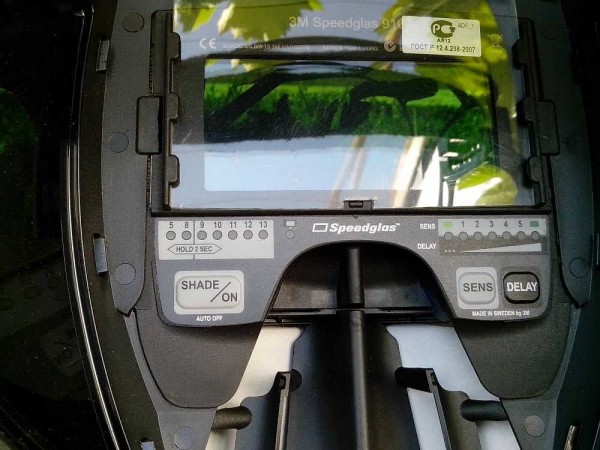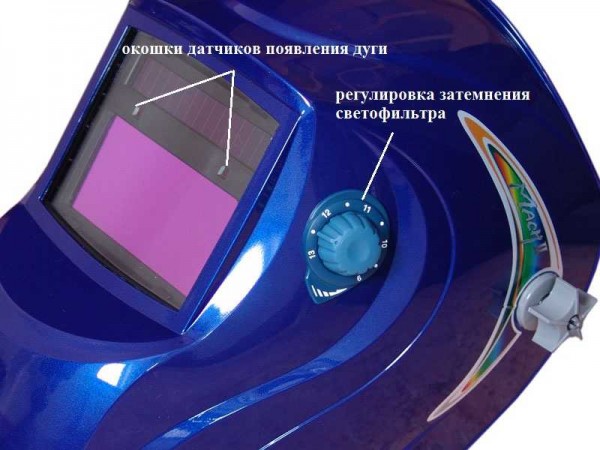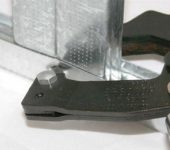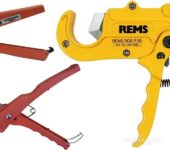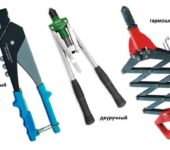Chameleon mask for welding: filter classification and mask selection
Chameleon welding helmets are so named because the light filter automatically changes the degree of shade depending on the light intensity. It is much more comfortable than a regular visor or an old type mask with a replaceable filter. Wearing a chameleon, you can see everything well before welding: the filter is almost transparent and does not interfere with your work. When the arc is ignited in a matter of fractions of a second, it darkens, protecting the eyes from burns. After the arc is extinguished, it becomes transparent again. You can carry out all the necessary manipulations without removing the mask, which is much more convenient than raising and lowering the protective screen, and much better than holding a shield in your hand. But an extensive selection of copies of different prices can be confusing: what is the difference, and which one is better? How to choose a chameleon mask is described below.
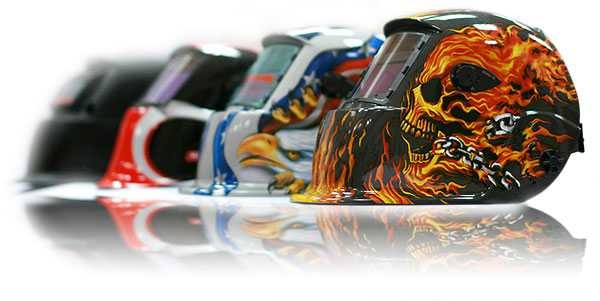
Chameleon welding masks are presented in a wide variety. The choice is not an easy task at all. Moreover, it is not so much the appearance that is important as the quality indicators.
The content of the article
Light filter in a chameleon: what is and which is better
The small glass that is installed on the welding helmet is a real miracle of science and technology. It contains the latest advances in optics, microelectronics, liquid crystals and solar energy. Here is a "glass". In fact, this is a whole multi-layer cake, which consists of the following elements:
- liquid crystal cells (several layers - the more the better);
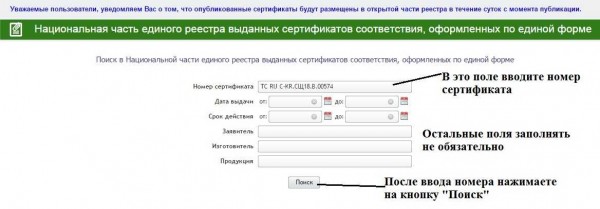
This is a form on the Russian Accreditation website for verifying the certificate. You can fill in only the number, leaving all other fields empty (To enlarge the image, right-click on it)
In the appropriate field, enter the number of the certificate and get the date of validity, information about the applicant, manufacturer. A small note: the abbreviation RPE stands for “optical protective equipment”. This is the name of the welder's mask in bureaucratic language.

If there is such a certificate, this message will appear. By clicking on the link, you will see the text of the certificate (To enlarge the image, right-click on it)
The most important thing is that you make sure that the given product (compare, by the way, the name and model) is safe for your health.
You might be interested in how to make a gazebo on a metal frame.
Classification of Automatic Welding Filters
Since the light filter and its quality are a key element in this product, the choice of a chameleon mask should be started with it. All of its indicators are classified according to the EN379 standard and must be displayed on its surface through a fraction.
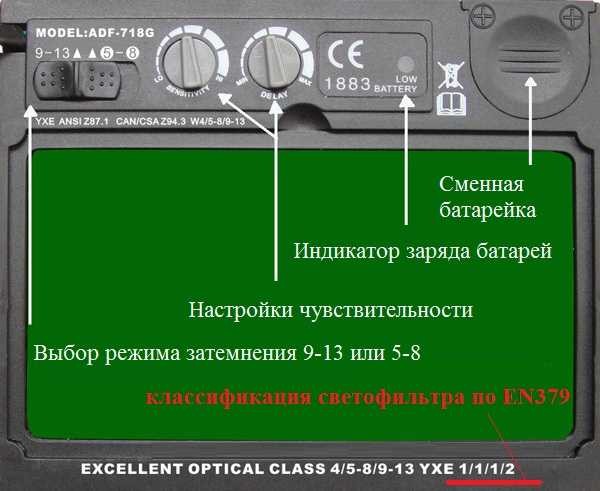
One of the light filters in the chameleon mask. Its classification is marked in red
Now in more detail what is hidden behind these numbers and what they should be. Each position can contain a number from 1, 2, 3. Accordingly, "1" is the best option - the first class, "3" - the worst - the third class. now about in which position which characteristic is displayed and what it means.
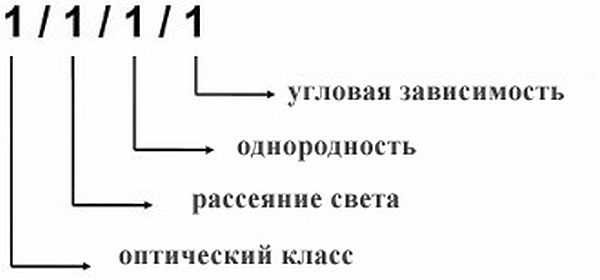
Explanation of the EN37 classification
Optical class
It reflects how clearly and without distortion you will see the picture through the light filter. Depends on the quality of the used protective glass (film) and the build quality. If "1" is in the first place, distortion will be minimal. If the values are higher, you will see everything as through curved glass.
Light scattering
Depends on the purity and quality of the optical crystals used. Shows the degree of "turbidity" of the transmitted image. It can be compared with wet car glass: as long as there are no encounters, drops hardly interfere. As soon as a light source appears, everything is blurred. To avoid this effect, it is necessary that the second position is "1".
Uniformity or homogeneity
Shows how evenly the filter is shaded in different parts. If the third position is one, the difference can be no more than 0.1DIN, 2 - 0.2 DIN, 3 - 0.3 DIN. It is clear that it will be more comfortable with uniform shading.
Angular dependence
Reflects the dependence of dimming on the viewing angle. Here, too, the best value "1" - the first class changes the shading by no more than 1 DIN, the second - to 2 DIN and the third - to 3DIN.
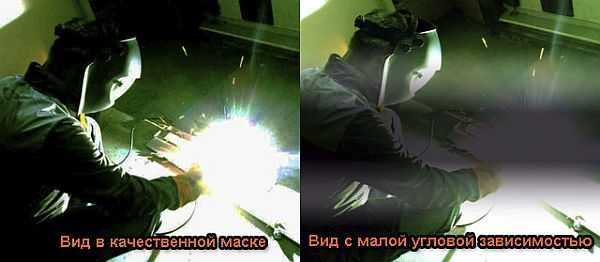
This is how the difference between a quality mask and a not very good light filter looks like "live"
From all this, it is clear that the more units in the filter characteristics, the more comfortable you will be working in the mask. This is what you need to focus on when choosing a chameleon welder mask. Professionals prefer at least 1/1/1/2. Such masks are expensive, but even with prolonged use, the eyes do not get tired.
For amateur welders, for work from time to time, you can get by with light filters simpler, but the 3rd class is considered "the last century". Therefore, you probably shouldn't buy masks with such filters.
And one moment. Sellers usually call this whole classification by one term "Optical class". It's just that this formulation accurately enough reflects the essence of all characteristics.
There are a few more chameleon settings that allow you to adjust the dimming mode for a given situation. They can be located inside, on a light filter, or they can be brought out in the form of handles on the left side of the mask. These are the following parameters:
- Dimming adjustment. Allows you to change the level of the current shade. You can make it lighter / darker without stopping from work if the regulator is outside. If it is located inside, you will need to stop, remove the mask and turn the adjuster. For non-professionals, this is normal: they don't need elaboration. But the pros do not always like external adjustments: they can hurt something.
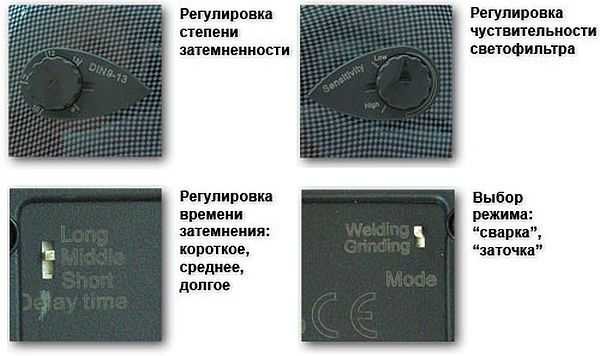
The regulators themselves can be in the form of switches, wheels, can be made in the form of touch switches
- Sensitivity adjustment. Located inside the mask, on the filter. With its help, you can set what the filter will work on: only on the arc, or also on bright light sources. If you work indoors, the sensitivity can be set high: the filter will darken when an arc occurs. Since there are no other variable light sources, it will not twitch. Outdoors with high sensitivity, it can also be triggered by sun glare. So here you have to reduce the sensitivity.
- Delay of mask enlightenment. It is necessary so that the eyes do not receive a light strike from the glowing metal after welding is completed. If there is no delay, the filter becomes lighter immediately and the bright glow of the weld pool hits the eyes. It is neither dangerous nor fatal, but unpleasant. The darkening delay allows you to "push back" the moment of filter clearing for some time. Also, this delay does not allow the filter to clear up if you cook with an arc break or when the electrode sticks. So the adjustment is necessary.
You may be interested in reading on the types of welds and joints, applied techniques and methods of welding.
Chameleon mask how to choose
In addition to the filter parameters, there are many other settings and features that can affect the choice.
- The number of arc detection sensors. There can be 2, 3 or 4. They react to the appearance of an arc. They can be visually seen on the faceplate of the mask. These are small round or square "windows" on the filter surface.For amateur use, 2 pieces are enough, for professionals - the more, the better: if some are blocked (overlapped by some object when welding in a difficult position), then the rest will react.
- Filter response speed. The spread of parameters here is large - from tens to hundreds of microseconds. When choosing a home welding mask, drill one whose chameleon will darken within 100 microseconds. For professionals, the time is less: 50 microseconds. Sometimes we do not notice light strokes, but their result is tired eyes, and professionals need them all day long. So the requirements are tougher.
- Filter dimensions. The larger the glass, the more view you get. But the size of the filter greatly affects the cost of the mask.
- Smooth or step adjustment of the degree of shading. Better - smooth. If the filter darkens / brightens irregularly, you will quickly get tired. In addition, he washes to start "blinking" from glare, which will not please.
- Initial shade and adjustment range. The lighter the filter in its original state, the better you will see it before welding. It is also desirable that there are two shade ranges: up to small degrees up to 8DIN when working with argon or with manual arc welding in low light. Also, less darkening may be needed by an older person. To work with inverters at high currents and in good light it is necessary to dim up to 13 DIN. So it is better if there are two modes: 5-8DIN / 8-13DIN.
- Power supply. Most auto-dimming welding helmets have two types of power cells: solar cell and lithium battery. This combined power supply is the most reliable. But at the same time, the lithium battery compartment must open in order to be able to replace the failed batteries. In some cheap masks, the batteries are integrated: you can remove them only by cutting the plastic (which sometimes our craftsmen do).
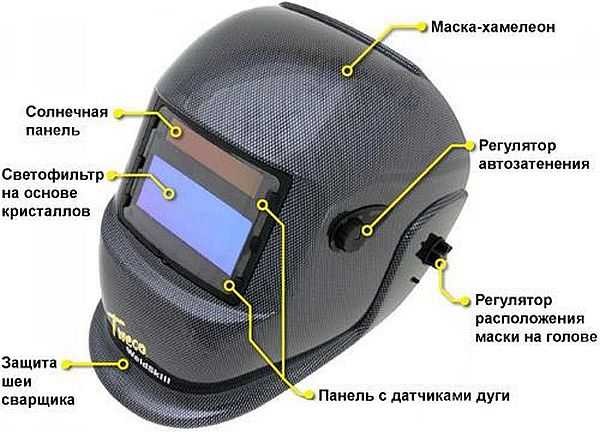
One of the models of the chameleon mask. Here you can also see a regulator for the position of the mask on the head and a neck protection shield.
- Weight. Masks can weigh between 0.8 kg and 3 kg. If you have to wear a three-kilogram weight on your head for seven or eight hours, by the end of the shift your neck and head will be like wood. For amateur welding, this parameter is not very critical, although it is also not at all comfortable to work in a heavy mask.
- Ease of attachment to the head. There are two attachment systems for the headband and the visor itself, but for these masks they are almost unimportant: you do not need to raise / lower the mask every time. It can be omitted throughout the entire work. What matters is how many adjustments there are and how tightly they fit the headband. It is also important that all these straps do not crush or rub, so that the welder is comfortable.
- The presence of an adjustment that allows you to move the flap away from the face. This is important if you need glasses for normal vision. Then the shield needs to be carried away from your face to fit your lenses.
Of the useful, but optional modes, there is also the ability to switch poppies from welding mode to grinding mode. With this switch, you actually turn off the power of the light filter, your mask becomes an ordinary shield.
Read about choosing a welding machine for your home or summer cottage here. And you can try the purchased mask when making metal barbecue.
Brands and manufacturers
You know how to choose a chameleon mask for welding, but how to navigate among the mass of manufacturers? In reality, everything is not very complicated. There are proven brands that always supply quality products and confirm their warranty obligations. There are not very many of them:
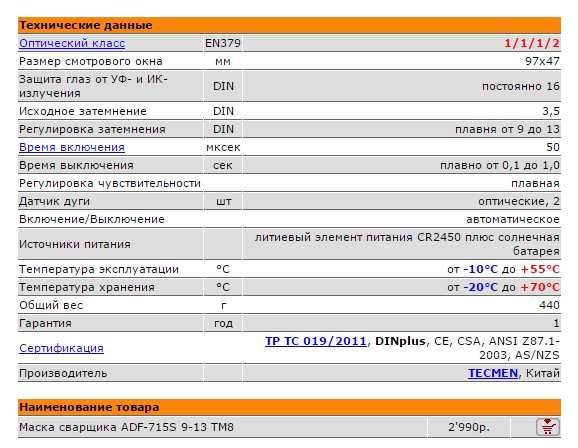
Technical characteristics of TECMEN DF-715S 9-13 TM8 chameleon mask
- SPEEDGLAS from Sweden;
- OPTREL from Switzerland;
- BALDER from Slovenia;
- OTOS from South Korea;
- TECMEN from China (don't be surprised, the masks are really good).
Choosing a chameleon mask for home use is not easy.On the one hand, it is necessary that it be of high quality, but obviously not everyone can afford to pay 15-20 thousand for it, and it is not profitable either. Therefore, you will have to forget about European manufacturers. Although they produce good masks, their prices are no less than $ 70.
There are many Chinese masks on the market of very low cost. But buying them is risky. If you want a proven Chinese brand, this is TECMEN. Here they have really certified factory quality chameleon masks. The model range is wide enough, prices - from 3 thousand rubles to 13 thousand rubles. There are first class light filters (1/1/1/2) and slightly worse, with all settings and adjustments. After the upgrade, even the cheapest mask for 3000 rubles (TECMEN DF-715S 9-13 TM8) has a replaceable battery, an enlightenment delay from 0.1 to 1 sec, smooth adjustment and a "grinding" operating mode. The photo below shows its technical characteristics. It's hard to believe, but it costs only 2990 rubles.
The owners speak well of the Resant's welding masks. There are not very many models, but MS-1, MS-2 and MS-3 are a good choice for little money (from 2 thousand rubles to 3 thousand rubles).

Resant's welding mask: MS-1, MS-2, MS-3 and MS-4
Resant masks MC-1 and MC-3 have smooth adjustment, which is undoubtedly more convenient. But in the chameleon MC-1 there is no sensitivity adjustment. They are unlikely to suit professionals, but they are quite suitable for home use.
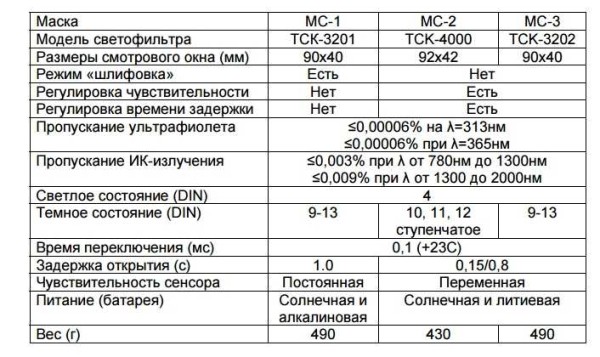
Technical characteristics of Resant's chameleon masks
Very good masks are produced by the South Korean company OTOS (Otos). Its prices are slightly higher than those given above, but there are two relatively inexpensive models: OTOS MACH II (W-21VW) for 8700 rubles and ACE-W i45gw (Infotrack ™) for 13690 rubles.
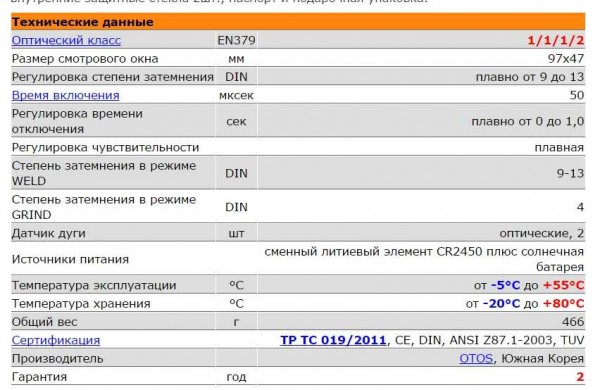
OTOS MACH II W-21VW Specifications This chameleon mask is a worthy choice even for professional use
About, how to choose electrodes for welding by an investor read here.
Welding Chameleon Operation
The main requirement for the care of the mask: the light filter must be taken care of: it is easily scratched. Therefore, you cannot put the mask face down. You only need to wipe it with an absolutely clean and soft cloth. If necessary, you can dampen the cloth with clean water. DO NOT wipe with alcohol or any solvents: the filter is covered with a protective film that dissolves in these liquids.
There is one more feature of any welding chameleons: they begin to "slow down" at low temperatures. That is, they are triggered with a delay, and in both directions - both for darkening and for enlightenment. The feature is very unpleasant, so it will not work normally in them in winter, even if the operating temperature is indicated from -10 ° C, as on the TECMEN DF-715S 9-13 TM8. Already at -5 °, everyone cannot darken in time. So in this regard, OTOS turned out to be more honest, indicating the starting operating temperature of -5 ° C.
Finally, watch a video on how to choose a chameleon mask for welding.
- Dimming adjustment. Allows you to change the level of the current shade. You can make it lighter / darker without stopping from work if the regulator is outside. If it is located inside, you will need to stop, remove the mask and turn the adjuster. For non-professionals, this is normal: they don't need elaboration. But the pros do not always like external adjustments: they can hurt something.

